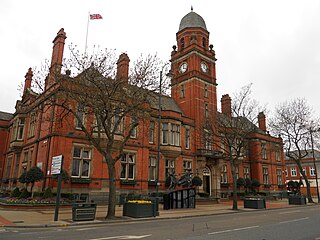
Potts of Leeds was a major British manufacturer of public clocks, based in Leeds, Yorkshire, England.

Potts of Leeds was a major British manufacturer of public clocks, based in Leeds, Yorkshire, England.

William Potts was born in December 1809 and was apprenticed to Samuel Thompson, a Darlington clockmaker. In 1833, at the age of 24, William moved to Pudsey near Leeds, to set up his own business. [1] Initially the business was primarily concerned with domestic timepieces, however this gradually expanded into the manufacture and repair of public clocks.
In 1862 the business moved to Guildford Street, Leeds, and later, a workshop for public clocks opened nearby in Cookridge Street. This heralded the most productive and profitable years of the business with large numbers of public clocks being installed both home and abroad for cathedrals, churches, town halls, schools, engineering works and railways. [1] Queen Victoria granted the company a Royal Warrant in 1897. [1]
The business was renamed William Potts & Sons Limited as a result of three of William’s sons joining the company, however, after the First World War, two sons started their own clockmaking business, Tom Potts left in 1928 and Charles Potts left in 1930. William Potts & Sons Limited joined the Smith of Derby Group in 1935, but, as a well-recognised name, Potts retained its identity and the Leeds base. Today the Potts name is still recognised and active in the north of Britain.
It is claimed that there are more than 1600 Potts clocks in existence around England. [2]


Potts' clocks were installed in public buildings, churches, railway stations, workplaces and other premises. According to Potts' register, 1,568 new clocks were installed and 54 of them subsequently transferred to new locations by the company. The total included, 363 quarter-chiming clocks and 510 hour-striking clocks. [3] Many were installed at locations in Yorkshire, [4] and Leeds had the most, [5] including examples on Leeds Town Hall and Leeds Corn Exchange. [1] The clock on the Pierhead Building at Cardiff Docks was installed in 1897, but was removed and sold in 1973. The mechanism was taken to Alabama, USA and returned to Cardiff in 2005. It was planned to install the Potts clock as a piece of contemporary art, encased in glass, in Cardiff city centre. [6]
Other clocks were installed further afield, Lerwick Town Hall's clock was installed in 1887, [7] and one on the Roman Catholic Church Hall in Melbourne, Australia dates from 1930. [8] Five clocks were exported to India but their locations are not known, two went to Russia and there is an example on the post office in Lyttleton, New Zealand. [9] Potts provided the mechanism for a floral clock at Belle Vue Zoological Gardens in 1936. [10]

Sheffield Town Hall is a municipal building on Pinstone Street in the City of Sheffield, England. The building is used by Sheffield City Council, and also contains a publicly displayed collection of silverware. It is a Grade I listed building.

Gillett & Johnston was a clockmaker and bell foundry based in Croydon, England from 1844 until 1957. Between 1844 and 1950, over 14,000 tower clocks were made at the works. The company's most successful and prominent period of activity as a bellfounder was in the 1920s and 1930s, when it was responsible for supplying many important bells and carillons for sites across Britain and around the world.

Morley Town Hall is a municipal facility in Morley, West Yorkshire, England. The town hall, which is the meeting place of Morley Town Council, is a Grade I listed building.

J. B. Joyce & Co, clockmakers, were founded in Shropshire in England. The company claim to be the oldest clock manufacturer in the world, originally established in 1690, and have been part of the Smith of Derby Group since 1965. The claim is challenged by another English firm of clockmakers, Thwaites & Reed, who claim to have been in continuous manufacture since before 1740, with antecedents to 1610.

The Pierhead Building is a Grade I listed building in Cardiff Bay, Wales. It was built in 1897 as the headquarters for the Bute Dock Company.

St Mary Street and High Street are major commercial streets in the Castle Quarter of Cardiff city centre, Wales, which form a major thoroughfare running south from the gatehouse of Cardiff Castle. High Street begins at the junction of Castle Street on the A4161 and ends at the junction of Church Street and Quay Street, from where St Mary Street begins until the roundabout at Callaghan Square on the A4160.

Benjamin Vulliamy, was a British clockmaker responsible for building the Regulator Clock, which, between 1780 and 1884, was the main timekeeper of the King's Observatory Kew and the official regulator of time in London. In 1773 Vulliamy had received a Royal Appointment as the King's Clockmaker.
Founded in 1856, the Smith of Derby Group are clockmakers based in Derby, England. Smith of Derby has been in operation continuously under five generations of the Smith family.

Bolton Town Hall in Victoria Square, Bolton, Greater Manchester, England, was built between 1866 and 1873 for the County Borough of Bolton to designs by William Hill of Leeds and George Woodhouse of Bolton. The town hall was extended in the 1930s to the designs of Bradshaw, Gass and Hope and has been designated a Grade II* listed building by English Heritage.

Yeadon Town Hall is a municipal building in Yeadon, West Yorkshire, England. It is Grade II listed.

Fulham Town Hall is a municipal building on Fulham Road, Fulham, London. It is a Grade II* listed building.

The Old Town Hall, Richmond on Whittaker Avenue in Richmond, London is a former municipal building which from 1893 to 1965 served as the town hall for the Municipal Borough of Richmond.

Ilkley Town Hall, on Station Road, Ilkley, West Yorkshire, is a Grade II listed municipal building designed by William Bakewell of Leeds. It forms the centre of a small complex of public buildings, which also includes Ilkley Library, and the King's Hall & Winter Garden theatre. The library, Town Hall and King’s Hall opened in 1908 opposite Ilkley railway station; the Winter Garden was added to the west in 1914.

Wakefield Town Hall is a municipal building in Wood Street in Wakefield, West Yorkshire, England. It remains a venue for weddings and civil partnerships but is no longer the headquarters of Wakefield Council which is now based at County Hall. The town hall is a Grade I listed building.

Launceston Guildhall and Town Hall is a municipal building in Western Road in Launceston, Cornwall, England. The building, which was the meeting place of Launceston Town Council, is a Grade II listed building.

Ossett Town Hall is a municipal building in the Market Place, Ossett, West Yorkshire, England. The town hall, which was the headquarters of Ossett Borough Council until 1974, is a grade II listed building.

Hyde Town Hall is a municipal building in the Market Street, Hyde, Greater Manchester, England. The town hall, which was the headquarters of Hyde Borough Council, is a grade II listed building.
James Ritchie & Son are a firm of Clockmakers in Broxburn, West Lothian, Scotland. The company was established in 1809 and is Scotland's oldest turret clock manufacturer.

Meltham Town Hall is a municipal building in Carlile Street in Meltham, West Yorkshire, England. The building, which formerly operated as the offices of Meltham Urban District Council, is now The Crossroads Centre, which operates the local foodbank.

Loftus Town Hall is a municipal building in Water Lane in Loftus, North Yorkshire, England. The structure, which accommodates the offices and meeting place of Loftus Town Council, is a grade II listed building.